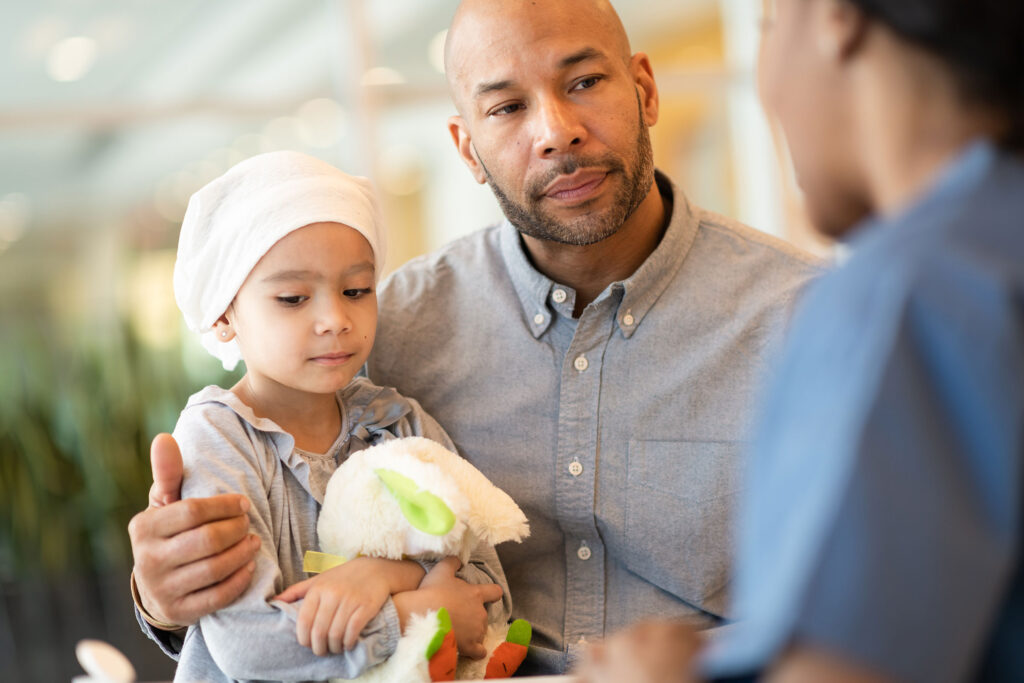Children with cancer and their families cope with physical symptoms and the emotional distress of a life-threatening diagnosis, but many also have to deal with stigmatization. Whether in the form of schoolmates bullying a child who has lost his hair, a neighbor avoiding a family out of discomfort, or parents blaming themselves for passing down “bad” genes, the stigma of a cancer diagnosis can have profound and damaging effects on young patients and their caregivers. Stigma can cause parents to delay seeking care, refuse treatment or stop treatment early — all of which lower a child’s chances of survival.
“Globally, treatment abandonment is a major reason why children die from cancers for which we have effective therapies, and a lot of that is due to stigma,” said Sara Malone, MSW, PhD, an assistant professor at the School of Public Health at Washington University in St. Louis. “None of the care that we provide matters if we can’t get kids and their families to show up for it. And if stigma is a driving reason that kids and their families aren’t engaging with the health-care system, then that feels like a problem we ought to solve.”
Before the global problem of stigma can be addressed, however, researchers need to understand it better. In a review published July 24 in the journal eClinicalMedicine, Malone and colleagues analyzed more than 2,000 research papers about stigma related to health conditions, representing studies in 101 countries. The researchers found that the studies used a variety of definitions of stigma and more than 750 distinct tools to measure it, making it impossible to draw generalizable conclusions about how stigma is experienced around the world.
“The rhetoric around stigma has historically been that it is so nuanced and varies so much across cultures and societies that you have to study it in this very specific, targeted way,” Malone said. “Our work has demonstrated that, actually, the experience of stigma is more alike than different, globally. But we’re currently up against the fact that we don’t have a good way to measure stigma and understand what is happening to kids with cancer.”
Of the 750-plus tools, none was specifically created with pediatric cancer in mind. The vast majority were for contagious diseases such as HIV infection and AIDS. A few were for adult cancer patients, but adult and pediatric cancer are stigmatized differently, making tools designed for adults inappropriate for children. Among other differences, children are rarely blamed for bringing illnesses on themselves, but adults are frequently harshly judged for what others deem to be unhealthy lifestyles.
So Malone, along with co-author Dylan Graetz, MD, MPH, an assistant faculty member in the Department of Global Pediatric Medicine at St. Jude Children’s Research Hospital, set out to create a tool to measure stigma experienced by children with cancer and their caregivers around the world. The two launched the RESPECT trial (REsearching Stigma in PEdiatric Cancer Tool) to develop two tools: one for children ages 8 to 17 who are undergoing treatment for, or are in remission from, cancer; and the other tool for their caregivers.
The trial is underway. Malone, Graetz and colleagues have completed the first step: designing an assessment tool and iteratively refining it in consultation with patients and caregivers to ensure that the survey asks the right questions in the right way. The tool was developed and tested simultaneously in three languages — English, Spanish and Arabic — and at four sites — St. Louis; Memphis, Tenn.; Guatemala City; and Amman, Jordan — to help ensure that it made sense across languages and cultures. After months of testing, they ended up with a 15-minute survey that asks children to rate statements such as, “Because of my cancer, I feel like I don’t fit in,” on a five-point scale from almost never to almost always. Parents are asked to rate similar statements about their own experiences, such as, “Because of my child’s cancer, people are uncomfortable around me.”
Now, the researchers are on step two: using the tool to investigate how stigma is experienced by children with cancer and their families. Malone, Graetz and their collaborators in Guatemala and Jordan are aiming to recruit 200 children and caregivers in each country by the end of the summer.
“We expect to see a lot of similarities in stigma across the three countries, but we also expect to find differences,” Malone said. “Maybe in one culture stigma is primarily happening at school, and in another it’s in the family or the community.
“The ultimate goal, of course, is to develop an intervention that will reduce stigma and make sure more children not only survive, but thrive,” she continued. “Developing a measurement tool is a very early step on that path, but it’s a necessary step. We can’t design an intervention and expect it to work if we don’t know what is going on.”
Malone S, Counts L, Zabotka L, Williams A, Loecher N, Wynja K, Bryan G, Tanner R, Caceres-Serrano, Ferrara G, Fuentes L, Bilbeisi T, Maheu M, Oelkers BK, Ogwo M, Yaeger L, Agulnik A, Graetz D. “Stigma measurement in health: a systematic review.” eClinicalMedicine. July 24, 2025. DOI: 10.1016/j.eclinm.2025.103360
This study was funded by St. Jude Children’s Research Hospital, the National Cancer Institute (grant number P30CA021765), the American Lebanese Syrian Associated Charities, and Siteman Cancer Center of Barnes-Jewish Hospital and Washington University School of Medicine in St. Louis. The views in this paper are those of the authors and don’t necessarily reflect the funding agencies.
RESPECT: (REsearching Stigma in PEdiatric Cancer Tool), ClinicalTrials.gov ID NCT06470230.
Writer
Tamara Schneider, MPH, PhD, is the senior science writer and assistant director of communications for WashU School of Public Health. She holds a bachelor’s degree in molecular biophysics & biochemistry and in sociology from Yale University, a master’s in public health from the University of California, Berkeley, and a PhD in biomedical science from the University of California, San Diego.
